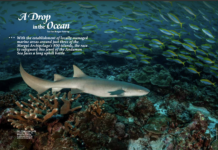To stop the destruction of sea life, the people from Malaysia’s marine park, Tun Mustapha decided to work with poachers instead of against them
Text and Photos Ben Blackledge
If you’re a thief, you don’t ring up law enforcement, promise a share of the loot, and compliment their work. But that’s exactly what one man did for Absan Saman. The warden of Tun Mustapha, Malaysia’s largest marine park, remembers the call he received from a poacher last year, offering him a fifth of the eggs from two illegally-raided nests on Tigabu Island in appreciation of his conservation efforts.
Related:Coral Conservation
Saman is a prominent personality in the area. The former fish-bomber stretches his arms wide as he describes the catch two days of fishing could bring in decades ago. Today, though, Sabah waters suffer the same issues plaguing reefs across Southeast Asia – overfishing, poaching, and destructive fishing practices – and Saman has experienced the effects of dwindling fish stocks firsthand. Not wanting his children to face an empty sea, he trained under the World Wide Fund For Nature (WWF) as an honorary wildlife warden to promote sustainable fishing in his local waters – work for which he receives monthly expenses.

People like Saman are promising early indicators for the success of a new type of environmental stewardship pioneered in Tun Mustapha’s marine protected area.
Named after Sabah’s first governor and gazetted in May 2016 – following 13-year-long negotiations with stakeholders, including 80,000 locals – Tun Mustapha is run using a softer, more-pragmatic approach that accounts for the realities of village life. Here, poachers are often neighbours and friends, and reporting infringements creates hostility. Instead, fishermen decide themselves which zones of park waters may be fished, and which are off-limits breeding sites. The WWF also funds and trains villagers in projects like restoring mangroves, which act as fish nurseries.
Related: Uncharted Territories
WWF Malaysia’s lead community organiser, Joannie Jomitol, says the organisation is hopeful about the recovering ecosystems and engaged communities. She adds that conservation bodies are making door-to-door trips to explain in layman terms how proper park management can benefit villagers.
“What we want to do is give them the knowledge and information they need to know about the situation of the sea and the fishery status, but through their own understanding, asking questions like: ‘What was it like 20 years ago?’” she says. “Because if you say the coral is damaged – no coral, no fish – they don’t see that. When they see coral, they see only rocks. You need to talk to them about things that relate to them, like fisheries and their livelihood.”

Though conservation education is still uneven among communities due to the park’s massive range, this is expected to improve as more of its 50 islands receive wardens. In the meantime, the endangered green turtle nests on Tigabu’s beaches have Saman to patrol them, and as the hatchlings struggle out to sea, it’s his job to gather the community to watch and teach – a sight that moves even the most hard-hearted of poachers to consider the consequences of their actions.
Related: UNESCO’s Latest Initiative Could Save Asia’s Reefs
For more stories and photographs from this issue, see Asian Geographic Issue 131, 2018











